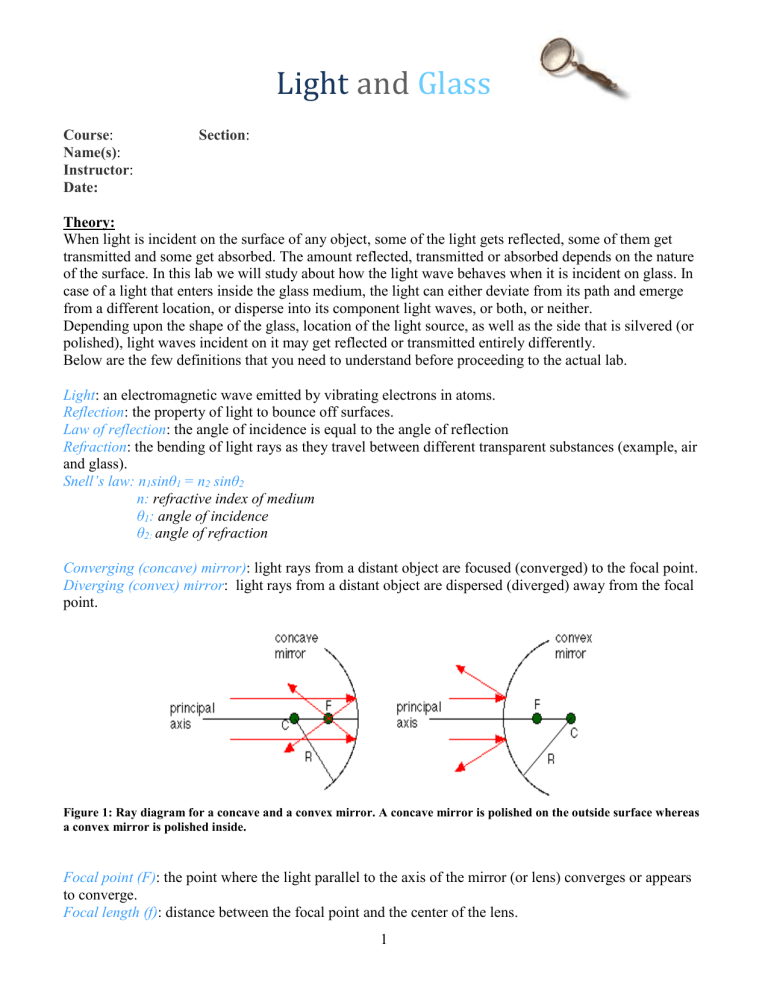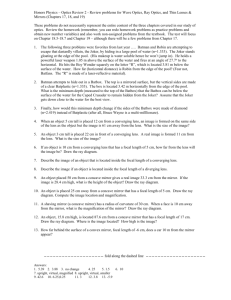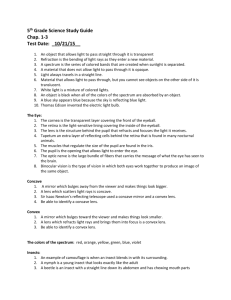Mirrors and lenses

Light
and
Glass
Course :
Name(s) :
Instructor :
Date:
Theory:
Section :
When light is incident on the surface of any object, some of the light gets reflected, some of them get transmitted and some get absorbed. The amount reflected, transmitted or absorbed depends on the nature of the surface. In this lab we will study about how the light wave behaves when it is incident on glass. In case of a light that enters inside the glass medium, the light can either deviate from its path and emerge from a different location, or disperse into its component light waves, or both, or neither.
Depending upon the shape of the glass, location of the light source, as well as the side that is silvered (or polished), light waves incident on it may get reflected or transmitted entirely differently.
Below are the few definitions that you need to understand before proceeding to the actual lab.
Light : an electromagnetic wave emitted by vibrating electrons in atoms.
Reflection : the property of light to bounce off surfaces.
Law of reflection : the angle of incidence is equal to the angle of reflection
Refraction : the bending of light rays as they travel between different transparent substances (example, air and glass).
Snell’s law: n
1 sinθ
1
= n
2
sinθ
2 n: refractive index of medium
θ
1
: angle of incidence
θ
2: angle of refraction
Converging (concave) mirror) : light rays from a distant object are focused (converged) to the focal point.
Diverging (convex) mirror : light rays from a distant object are dispersed (diverged) away from the focal point.
Figure 1: Ray diagram for a concave and a convex mirror. A concave mirror is polished on the outside surface whereas a convex mirror is polished inside.
Focal point (F) : the point where the light parallel to the axis of the mirror (or lens) converges or appears to converge.
Focal length (f) : distance between the focal point and the center of the lens.
1
Center of curvature (C) : radius of curvature of the mirror or lens.
Converging (convex) lens : lens that is thick in the middle. Light rays form distant objects are focused
(converged to the focal point.
Diverging (concave) lens : lens is thinner in the middle. Light rays from a distant object are dispersed
(diverged) away from the focal point.
Figure 2: Ray diagram for a convex and a concave lens. The convex lens is thicker at the center and thinner towards the edge, whereas concave lens is exactly the opposite. No surface is polished in a lens.
Real image : an image that can be focused on a screen
Virtual image : this image cannot be focused on a screen and appears to be inside the mirror or lens
In this lab we will be using the Virtual program to understand how changing position of the object affect the location and size of the image formed by a convex and concave mirror and lens. Furthermore, we will vary the position of the light source and try to study the property of the image formed.
Equipment Required :
Optical bench, ruler, candle or light source, lighter, concave and convex mirrors and lenses, screen capturing the image
Lab Procedures :
1) Study the nature of images produced by concave and convex mirrors and lenses.
On your lab computer, you can use a simulation program to see how the position of the object affects the image produced by different lenses and mirrors.
On your desktop, go to “Exploration of Physical Science, Simulation Library Vol. II”
“Waves/Light”
“Light”
“Lenses and Mirrors” to see how changing the position of an object can alter the size, position, and nature of the image. Use this as a guide to do your experiment, and complete the data tables.
2) Determine the focal lengths of the mirrors and lenses you are given and record them in Table 1 .
3) Set up the optical bench with a light source (example: candle), mounted mirror or lens and screen.
4) Move the light source (or object) to different locations (beyond 2F, between 2F and F , at F , and between F and the mirror/lens) and study the nature of the resulting image. Record your observations in the appropriate tables.
2
Data Tables :
Table 1 : Focal lengths of the given mirrors and lenses
Surface
Manufacturer’s stated
Focal length (f) (cm)
Convex lens
Concave lens
Concave mirror
Convex mirror
Table 2: Convex/Converging Lens
Note: f is the focal length
2f is twice the focal length
Position of light source (p)
Beyond 2f
Between 2f and f
Position of image
(q)
Information about Image
Real or Virtual Upright or
Inverted
At f
Between f and lens
Table 3: Concave/Diverging Lens:
Note: f is the focal length
2f is twice the focal length
Position of light source (p)
Beyond 2f
Between 2f and f
At f
Between f and lens
Position of image
(q)
Information about Image
Real or Virtual Upright or
Inverted
Larger or Smaller
Larger or Smaller
3
Table 4: Concave/Converging Mirror
Note: f is the focal length
2f is twice the focal length
Position of light source (p)
Beyond 2f
Between 2f and f
Position of image
(q)
At f
Between f and mirror
Table 5: Convex/Diverging Mirror
Note: f is the focal length
2f is twice the focal length
Position of light source (p) Position of image
(q)
Beyond 2f
Between 2f and f
At f
Between f and mirror
Graphs :
None required
Calculations :
Mirror equation :
1/p + 1/q = 1/f p : distance of object (cm) q : distance of image (cm) f : focal length (cm)
Magnification (M) :
M= -q/p
Information about Image
Real or Virtual Upright or
Inverted
Information about Image
Real or Virtual Upright or
Inverted
Larger or Smaller
Larger or Smaller
4
Table 6: Calculated focal lengths:
Mirror/Lens
Convex lens
Concave lens
Concave mirror
Manufacturer’s stated focal length
Estimated focal length
(by focusing a distant light source)
Calculated focal length
(1/p + 1/q = 1/f)
Convex mirror
Answers to questions :
1. What is the difference between a real and virtual image?
2. Is the image you see in your household mirror real or virtual?
3. When does a converging lens form a virtual image?
4. Are the images formed by a diverging lens real or virtual?
5. When does a converging mirror form a virtual image?
6. Are the images formed by a diverging mirror real or virtual?
Conclusions :
5








